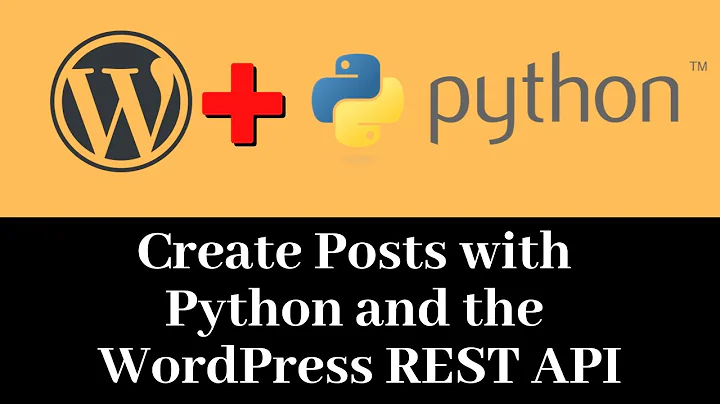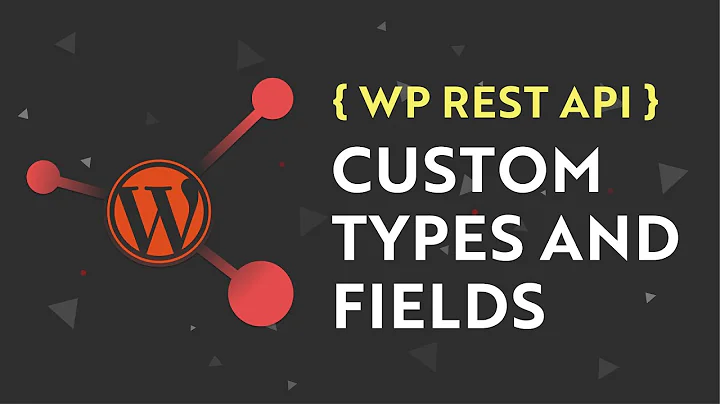Publish WordPress Post with Python Requests and REST API
Solution 1
I was able to solve this
-
I installed & activated this plugin on my wordpress https://wordpress.org/plugins/application-passwords/
-
follow the help text there and create your password string for your userid - assume it is mypassword123
-
now do this on your terminal "admin:mypassword123" | base64
You will get a new password - say pwdabc123
- Code looks like
url_srcdest = "http://example.com/wp-json/wp/v2/pages/"
headers = {'Content-Type': 'application/json',
'Authorization': 'Basic pwdabc123',
'Username': '<your username>',
'Password':'pwdabc123'}
data = \
{
"title":"Testing via API via Python",
"content":"tEST CONTENT OF THE THIS TEST PAGE via PYTHON",
"status": "publish"
}
response = requests.post(url_srcdest, data=json.dumps(data), headers=headers)
Solution 2
you missed:
-
authIS yourjwt token, NOTbase64 encode token-
jwt tokenis got fromPOST /wp-json/jwt-auth/v1/token
-
How to get jwt token ?
prerequisite
installed jwt plugin
install and enable WordPress plugin:
wordpress server enable jwt authorization
for example, my wordpress server is: CentOS
- edit
.htaccessin wordpress root folder
added:
RewriteEngine on
RewriteCond %{HTTP:Authorization} ^(.*)
RewriteRule ^(.*) - [E=HTTP_AUTHORIZATION:%1]
- edit
wp-config.php
add:
define('JWT_AUTH_SECRET_KEY', 'anyValueIsOk');
-
anyValueIsOk: change to yours, any value is OK- just do NOT tell other, ^_^
- Remember
service php-fpm restartafter edit php file
POST /wp-json/jwt-auth/v1/token to generate jwt token
call REST api to generate jwt token
POST https://www.yourWebsite.com/wp-json/jwt-auth/v1/token
{
"username": "wordpress_username",
"password": "wordpress_password"
}
-
wordpress_username: here is youradmin -
wordpress_password: here is your123456
response:
{
"token": "eyJ0eXAiOxxxxxxxxxxxxHYBhtuzc",
"user_email": "[email protected]",
"user_nicename": "xxx",
"user_display_name": "xxx"
}
-
eyJ0eXAiOxxxxxxxxxxxxHYBhtuzc: is the jwt token, which is what your need
[Optional] validate token is valid
POST https://www.crifan.com/wp-json/jwt-auth/v1/token/validate
headers:
Authorization: Bearer eyJ0eXAiOxxxxxxxxxxxxHYBhtuzc
response:
{
"code": "jwt_auth_valid_token",
"data": {
"status": 200
}
}
Additionally: use python call wordpress REST api to create posts
code:
import requests
your_jwt_token = "xxx"
curHeaders = {
"Authorization": "Bearer %s" % your_jwt_token,
"Content-Type": "application/json",
"Accept": "application/json",
}
categoryIdList = []
tagIdList = []
if categoryNameList:
# ['Mac']
categoryIdList = self.getTaxonomyIdList(categoryNameList, taxonomy="category")
# category nameList=['Mac'] -> taxonomyIdList=[1374]
if tagNameList:
# ['切换', 'GPU', 'pmset', '显卡模式']
tagIdList = self.getTaxonomyIdList(tagNameList, taxonomy="post_tag")
# post_tag nameList=['切换', 'GPU', 'pmset', '显卡模式'] -> taxonomyIdList=[1367, 13224, 13225, 13226]
postDict = {
"title": title, # '【记录】Mac中用pmset设置GPU显卡切换模式'
"content": content, # '<div>\n 折腾:\n </div>\n <div>\n 【已解决】Mac Pro 2018款发热量大很烫非常烫\n </div>\n <div>\n 期间,...performance graphic cards\n </li>\n </ul>\n </ul>\n </ul>\n <div>\n <br/>\n </div>'
# "date_gmt": dateStr,
"date": dateStr, # '2020-08-17T10:16:34'
"slug": slug, # 'on_mac_pmset_is_used_set_gpu_graphics_card_switching_mode'
"status": status, # 'draft'
"format": postFormat, # 'standard'
"categories": categoryIdList, # [1374]
"tags": tagIdList, # [1367, 13224, 13225, 13226]
# TODO: featured_media, excerpt
}
yourHost = 'https://www.crifan.com'
createPostUrl = yourHost + "/wp-json/wp/v2/posts" # 'https://www.crifan.com/wp-json/wp/v2/posts'
resp = requests.post(
createPostUrl,
# proxies=self.requestsProxies,
headers=curHeaders,
# data=json.dumps(postDict),
json=postDict, # internal auto do json.dumps
)
response example:
{
"id": 70410,
"date": "2020-02-27T21:11:49",
"date_gmt": "2020-02-27T13:11:49",
"guid": {
"rendered": "https://www.crifan.com/?p=70410",
"raw": "https://www.crifan.com/?p=70410"
},
"modified": "2020-02-27T21:11:49",
"modified_gmt": "2020-02-27T13:11:49",
"password": "",
"slug": "mac_pip_change_source_server_to_spped_up_download",
"status": "draft",
"type": "post",
"link": "https://www.crifan.com/?p=70410",
"title": {
'raw": "【已解决】Mac中给pip更换源以加速下载",
"rendered": "【已解决】Mac中给pip更换源以加速下载"
},
"content": {
...
}
}
Note:
- latest full code:
- wordpress official doc: Create a Post
more detail pls refer my Chinese posts:
- 【已解决】用Python发布印象笔记帖子内容到WordPress网站
- 【已解决】用Python发布帖子到WordPress用什么库和调用哪些接口
- 【已解决】用Python通过WordPress的REST的API发布文章post
- 【已解决】给crifan.com的WordPress网站REST的API添加JWT的token认证
- 【已解决】WordPress的jwt-auth用Postman去测试生成token和验证token
- 【已解决】Python把印象笔记帖子内容通过WordPress的REST的post接口去上传到crifan.com
Related videos on Youtube
Cl0udSt0ne
Updated on May 15, 2022Comments
-
Cl0udSt0ne 13 days
I try to publish post to WordPress blog with python requests and rest api by following code:
auth = 'Basic ' + str(base64.b64encode(b'admin:123456'), 'utf-8') headers = {'Authorization': auth} body = {'title': 'Hello World'} r = requests.post('wp-json/wp/v2/posts', headers=headers, data=body)and always got 401 error:
>>> r.text '{"code":"rest_cannot_create","message":"Sorry, you are not allowed to create posts as this user.","data":{"status":401}}'I'm pretty sure that the account admin and password is correct and has administrator role, Did I miss anything?
-
 Alex R over 3 yearsFor some people (me) this is only a partial solution... it leads to an issue with "Basic Authorization Headers missing" ... the quest for a working solution continues at wordpress.stackexchange.com/questions/328304/…
Alex R over 3 yearsFor some people (me) this is only a partial solution... it leads to an issue with "Basic Authorization Headers missing" ... the quest for a working solution continues at wordpress.stackexchange.com/questions/328304/… -
 disruptive almost 3 yearsDoes not work. Not sure if this ever worked, but not reproducible.
disruptive almost 3 yearsDoes not work. Not sure if this ever worked, but not reproducible.




